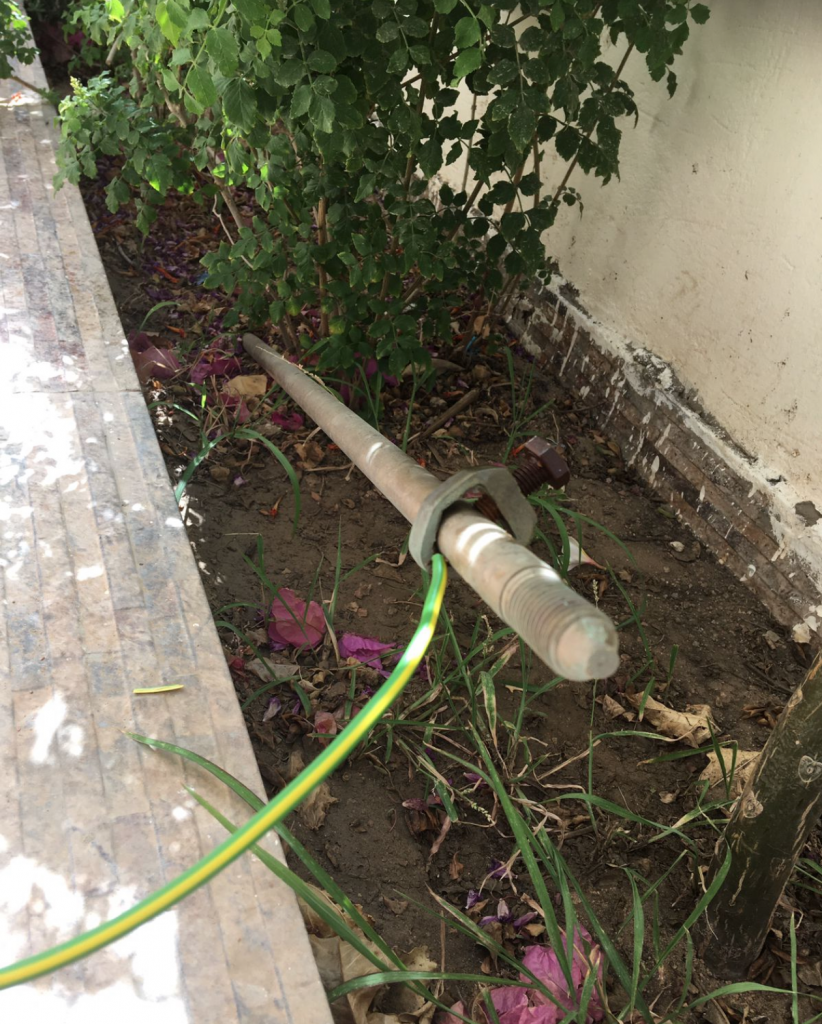A. Needed material
- 1 Multimeter with alternating voltage 2 – 200 Volt range
- 1 grip in conductive metal
- 1 crocodileconnectioncable (or wire you can tape onto grip)
- 1 electrical connection (black) large for crocodileconnetion and pin of multimeter (black) or smaller (white) for wire connection
- Earthing wire to earthing outside at earthing pin or inside at coldwaterconnection under sink or with copper piece connected in watersink in floor
- screwdriver, cutter knife, cutter tang, tape
B. Instructions
- Connect the earthing wire outside at a rod in wet soil or if not possible, inside at cold water supply under sink at metal connection or in watersink in floor with connected piece of copper rod .
- Connect the other end to the screwable connection (transparant)
- Connect the red wire pin ending to the screwable connection and plug the other end into the Multimeter
- Connect a conductive grip to a crocodile wire end or tape the metal pin ending of Multimeter connection (black) to the grip directly and plug in the end of Multimeter connection into the Multimeter next to the red connection.
- Switch the Multimeter on and put the Multimeter onto 2, 20 or even 200 Volt setting (alternating voltage ~) covering the measured voltage.
- Test your E-stressmeter by touching for example the wall to see if the Multimeter shows you the voltage of the wall, floor, in bed or anything you touch (with shoes on to isolate yourself from floor).

Multimeter in 20 Volt alternating ~ position for general measurements.
Red pin connected to earthing wire by electrical screwable connection (white).
Black pin connected to larger electrical screwable connection (black). Other end connected to metal conductive rod serving as grip by crocodile connection.
Alternative to crocodile wire is to tape copper ending to grip.
Earthing wire:
16 mm2 for whole house (official)
6 mm2 for a few sockets
3 mm2 in the house for each socket

Earthing rod: 150 x ca. 2 cm in copper with copper clamp for grounding a whole house.
Normally, the earthing rod has to be installed vertically into the ground.
In the case of not having enough space to install into the soil, you can install the earthing rod this way.
The earthing rod needs to be in wet soil as dry sand is isolating and cannot give you any earthing.
How to measure “E-stress”
A. Touch with one hand what you want to measure or measure the basic E- stress laying in bed, sitting on computer etc.. while you hold with the other hand the grip of E-stressmeter (wear isolating/normal shoes).
B. The tension on our body is measured in Volt; here the German Building Biology evaluations:
> 0,1 Volt = strong disturbing
> 1,0 Volt = extreme disturbing
A good connection has always < 0,05 Volt.

Measurement of an unearthed Mac laptop (earthing cable not sold but can be purchased online) with up to 90 Volt tension on the Mac and also on the body while working on laptop. Fridges have about 50 – 80 Volt.
This is 900 times more than already disturbing impact and definitief very unhealthy for us.
However, whenever we earth this laptop, your body even is in earthed connection what would be very healthy. Laptops and any electrical devices (fridge, oven, washing machine…) should be earthed with an earthing connection. We will introduce earthing support materials in the near future….
